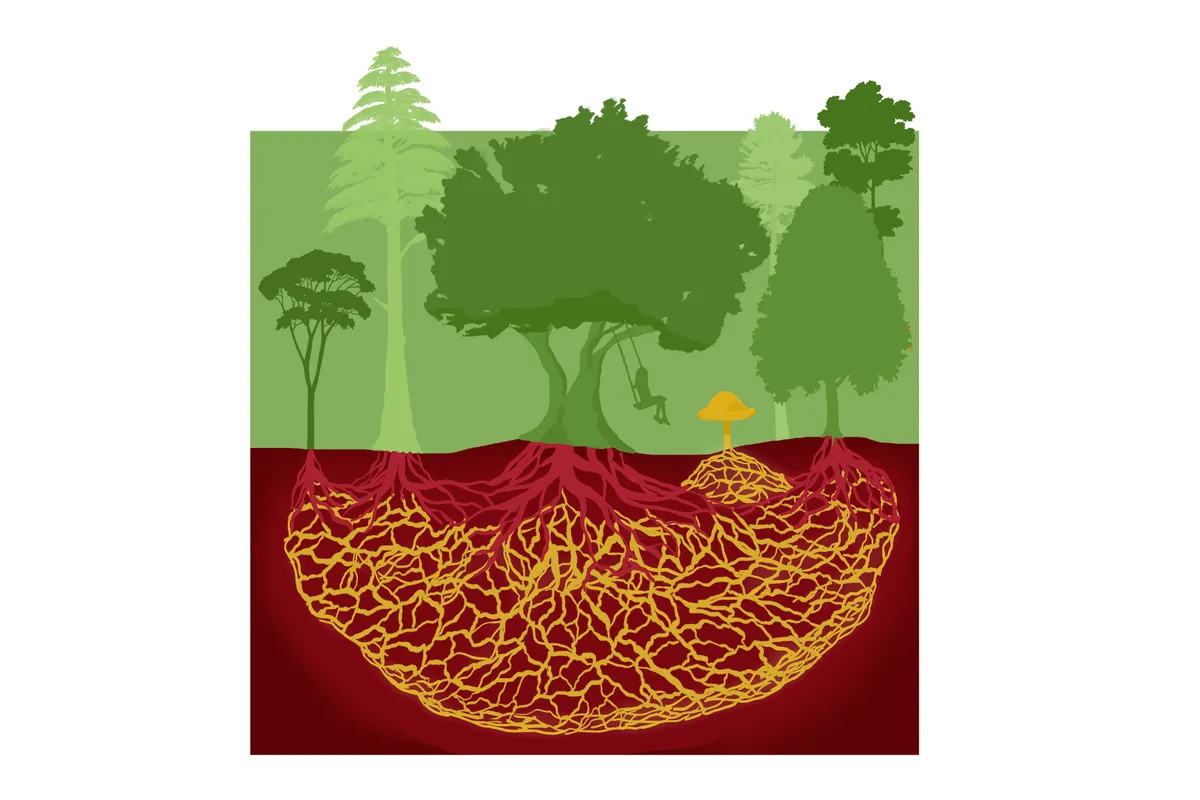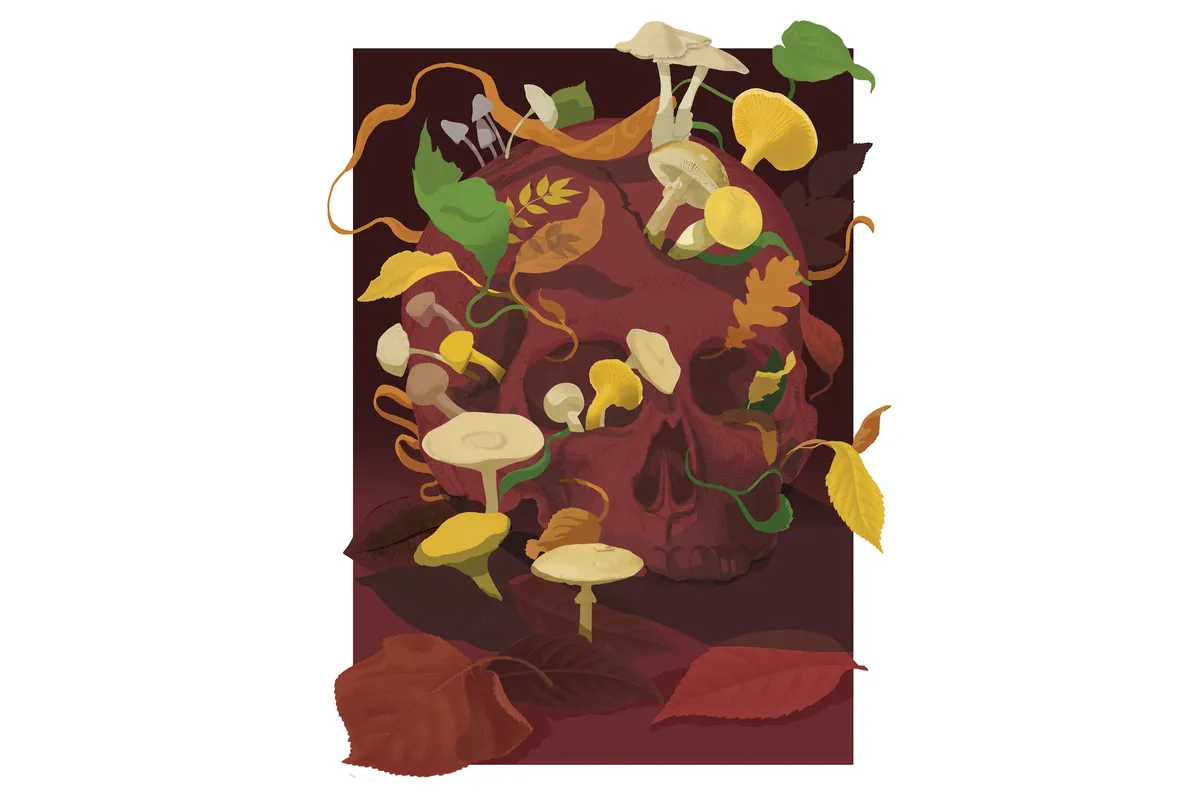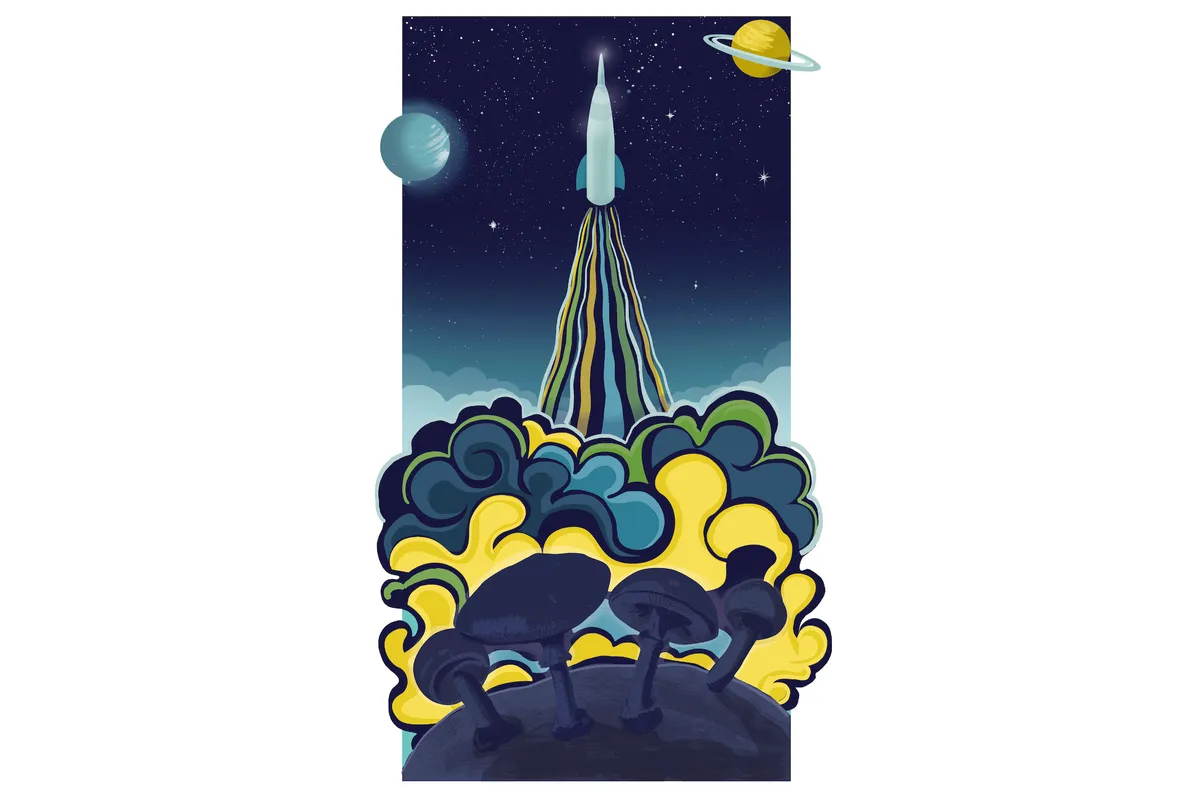What are fungi?
Fungi are decomposing, fermenting, edible, toxic, carbon-sequestering, disease-causing, disease-curing, pollutant-busting, mind-bending, rain-generating, zombie-making marvels. They underpin almost all life onEarth,but are mostly situated underground andoftenoverlooked.
When we think of fungi, mushroomsspring to mind, but these are just the small ‘above ground’ portion of the organism. Mushrooms are the fruiting body of the fungus, like the apples on a tree. Most of the fungus is hidden underground in the form of a branching network of tubular filaments called mycelium. If youtook a teaspoon of healthy soil and lined up all the mycelium within it, itwould stretch up to 10km.
Spread over 9km2, Oregon’s ‘Humongous Fungus’ is thought to be the world’s largest living organism.
Plant or animal?
Neither. Fungi belong to their own kingdom of life. It contains an estimated 2.2 to 3.8 million species, of which only 148,000 species or so have been described. Fungi used to be seen as simple plants, but scientists now realise that they are more closely related to animals than plants. Thousands of new fungal species are discovered every year.
How big are fungi?
Fungi come in a wide range of sizes. They can be single-celled and microscopic, like the yeast used in the beer-brewing industry, but they can also be multicellular and massive.
Spread over an astonishing 9km2, the ‘Humongous Fungus’ in Oregon’s Malheur National Forest is thought to be the world’s largest living organism. It weighs hundreds of tonnes and is estimated to be between 2,000 and 8,000 years old.
How do fungi interact with plants?
Around 90per centof land-living plants have fungi living in their roots. A single plant can house dozens of different species. Mycorrhizal fungi, as they are known, send out fine fungal tubes thatpenetrate the root tips of plants. The result is a mutually beneficial relationship, where the fungisiphon sugars from the plant, and the plant receives water and nutrients in return.
The plant also becomes tapped into themuch wider network of sprawling underground filaments, known as the Wood Wide Web. Plants near and far are connected by it. It enables them to share resources, such as nutrients and carbon, and also information. When broad bean plants are attacked by aphids, for example, they use the subterranean messaging system to send warning signals to neighbouring plants, which respond by releasing aphid-repelling chemicals.

How (and what) do fungi eat?
Fungi digest their food externally by secreting enzymes and then absorbing dissolved organic matter. Some fungi actively capture their prey.Arthrobotrys oligosporalures nematode worms to it by releasing molecules that smell like the worm’s natural food. On arrival, the hapless worm is then dissolved and digested.
Manyfungi feed on dead or decaying material, such asrotting logs or animal corpses. As such, they play a vital role inrecycling the world’s organic matter. Other fungi are parasitesthatfeed on living organisms.Dutch elm disease (which affects trees) and ringworm (which affects people) are caused by parasitic fungi.All this is just for starters, as fungi can also digest rock, crude oil, plastics, cardboard andevenexplosive TNT.

Where do fungi live?
Just about everywhere, in just about everything… living organisms, soil, air, water, rock, even nuclear waste sites. Fungi found growing at the ruined Chernobyl nuclear reactor in Ukraine can absorb high levels of radiation, which they use as a source of energy. Now scientists are exploring whether fungi like this could help to protect people from radiation during deep space missions.
How do fungi reproduce?
They can reproduce sexually, asexually (without sex) and parasexually (where tiny filaments called hyphae fuse together). Often, reproduction involves the production of spores, which are a bit like the seeds of a plant. Spores are dispersed into the environment, enabling the fungus to colonise new areas.
Some fungi eject spores explosively, accelerating up to 10,000 times faster than a post-launch Space Shuttle. Others create their own microclimates. As water evaporates from the gills of a mushroom, it can create an updraughtthathelps tolift spores into the air.

When did fungi first evolve?
Around a billion years ago. The first fungi would have been small, aquatic,single-celled organisms.Roughly500 million years ago, they helped plants move out of the water onto the land, by acting as their root systems.Then100million years later, fungi were the tallest living things onEarth.Prototaxiteswas a massive, trunk-like fungusthatgrew up tonine metres in height.
Can you farm fungi?
Yes, but for further advice, please ask the leafcutter ant. These industrious insects feed the leaf fragments they collect to the fungi that they cultivate inside their enormous underground nests. The fungi are fed to the ant’s larvae, and the adults keep the resource in tip-top condition by obsessively monitoring it, feeding it and keeping it pest free.
Can fungi make zombies?
Yes,theunlucky carpenter antcan becomethe victim ofOphiocordyceps unilateralis, the zombie-ant fungus.At the start of anextraordinarysequence of events, the brain of an infected ant becomes hijacked,prompting it to climb a nearby plant and bite into a leaf that is exactly 25cm above the ground, atjust the right temperature and humidity for the fungus to grow.
The fungus eats the ant’s internal organs and extends a long stalk through its head, which then bursts and rains spores down onto any ants below. The cycle of zombificationcontinues.
What is the most helpful fungus?
Fungi can be killers, but they can also save lives. The antibiotic penicillin is produced by the fungusPenicillium. It was discovered, by accident, almost 100 years ago, when Alexander Fleming spotted a bacteria-slaying mould growing on a forgotten Petri dish.
Since then, penicillin has saved hundreds of millions of lives, added 20 years of life expectancy across the world, and paved the way for countless procedures, such as caesareans and organ transplants, to be performed with a reduced risk of infection.
Penicilliumis alsohelpfulin food production.Penicillium camemberti and Penicillium roquefortiare used in Camembert, Brie, Roquefort and many other cheeses, whilePenicillium nalgiovenseis used to boost the flavour of certain sausages and hams.
Fungi can be killers, but they can also save lives. The antibiotic penicillin is produced by the fungus Penicillium.

What is the deadliest fungus?
Responsible for 90per centof the world’s mushroom-related fatalities, the deathcap mushroom is officially the world’s most poisonous mushroom. It looks like some edible mushrooms, such as thepuffball andpaddy straw, but eating it can lead to organ failure, seizures, coma and death.
Elsewhere, the chytrid fungus is decimating the world’s amphibians. It enters the animals’ bodies through their skin, upsets their fluid balance, and kills by causing heart failure. Spread around the world by the commercial trade in amphibians, it’s now found on every continent except Antarctica (where there are no amphibians).
Over the past 50 years, it has caused the decline of more than 400 amphibian species, and the extinction of 90.
The chytrid fungus has caused the decline of over 400 amphibian species, and extinction of 90.
How could fungi be used in the future?
There are so many opportunities for fungi. Fungi can be used to break down pollutants, such as pesticides, plastics and crude oil. Mycelium mats can filter contaminants, such as heavy metals, from dirty water.
Fungi can be used to break down waste products from food production andthe building sector, and build sustainable, carbon-neutral materials, such as fabrics and construction materials. TheTrichoderma fungus can turn crop waste into bioethanol, while elsewhere in agriculture, fungi are being used to boost crop growth and help control disease.

6 ways that fungi affect our lives
- Itaconic acid, derived from Aspergillus fungi, is used in a wide range of industries. Products include LEGO, plastic car parts, printing inks, UV coatings and synthetic rubber.
- More than 200 species of fungi are thought to be hallucinogenic. Psilocybin, found in magic mushrooms, is being explored as a treatment for depression and anxiety.
- Adidas has developed a pair of trainers made from mycelium, and Stella McCartney has premiered a ‘panelled bustier and utilitarian trouser set’ fashioned from the same fungal product.
- Fungi can influence the weather. When their spores occur in clouds, they can seed raindrops and spur the formation of ice crystals, which can fall as snow, sleet or hail.
- The global market for edible mushrooms is worth over $42bn per year. But out of the estimated 10,000 mushroom species found worldwide, only about 350 species are known to be edible.
- Most fungi have cell walls made of chitin, which is a substance found in the exoskeletons of insects and the shells of crabs and lobsters.
Read more about fungi:
- How most life on Earth is dependent on fungi – including you
- Blue denim, the death of the dinosaurs, and 8 other things you didn’t know fungi played a role in
- Merlin Sheldrake: How have fungi shaped the world?
- Mushroom magic: 5 ways fungus-based technology will change the world
To submit your questions email us at questions@sciencefocus.com (don't forget to include your name and location)